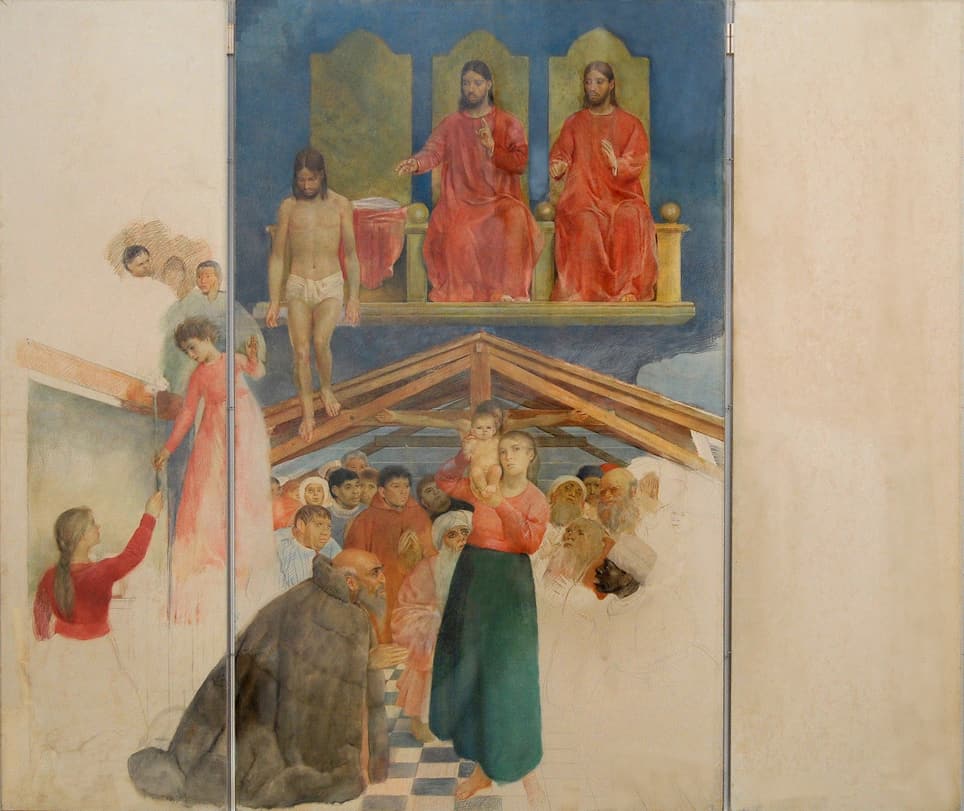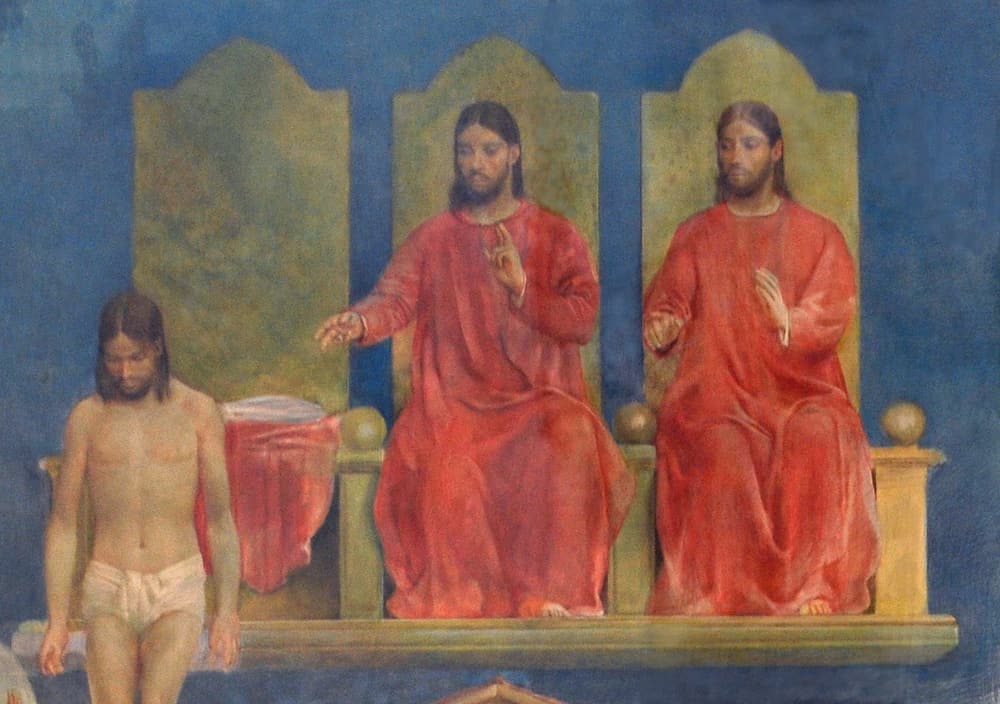December 23: The Humility of Christ
♫ Music:
Monday, December 23
Title: THE HUMILITY OF CHRIST
Scripture: Luke 2: 4-7, Philippians 2:5-7
Joseph also went up from Galilee, from the city of Nazareth, to Judea, to the city of David which is called Bethlehem, because he was of the house and family of David, in order to register along with Mary, who was engaged to him, and was with child. While they were there, the days were completed for her to give birth. And she gave birth to her firstborn son; and she wrapped Him in cloths, and laid Him in a manger, because there was no room for them in the inn.
Have this same attitude in yourselves which was in Christ Jesus [look to Him as your example in selfless humility], who, although He existed in the form and unchanging essence of God [as One with Him, possessing the fullness of all the divine attributes—the entire nature of deity], did not regard equality with God a thing to be grasped or asserted [as if He did not already possess it, or was afraid of losing it]; but emptied Himself [without renouncing or diminishing His deity, but only temporarily giving up the outward expression of divine equality and His rightful dignity] by assuming the form of a bond-servant, and being made in the likeness of men [He became completely human but was without sin, being fully God and fully man].
Poetry:
After Us
By Connie Wanek
I don't know if we're in the beginning or in the final stage.
- Tomas Tranströmer
Rain is falling through the roof.
And all that prospered under the sun,
the books that opened in the morning
and closed at night, and all day
turned their pages to the light;
the sketches of boats and strong forearms
and clever faces, and of fields
and barns, and of a bowl of eggs,
and lying across the piano
the silver stick of a flute; everything
invented and imagined,
everything whispered and sung,
all silenced by cold rain.
The sky is the color of gravestones.
The rain tastes like salt, and rises
in the streets like a ruinous tide.
We spoke of millions, of billions of years.
We talked and talked.
Then a drop of rain fell
into the sound hole of the guitar, another
onto the unmade bed. And after us,
the rain will cease or it will go on falling,
even upon itself.
A LONG WAY DOWN
In this annual feast of riches that is this calendar, where metaphor is shared amongst many interdependent artistic languages, there is in this particular window into the Incarnation a special irony. In our scripture today the great apostle Paul perhaps struggles to put into words something of the immense scope of the “self-emptying” of Jesus divesting himself of unimaginable power (but not character) to descend to our level. Paul knows what it means to lose the prestige of being a Rabbinical insider amongst the Jewish elite of Jerusalem, to experience abandonment and marginalization at the hands of his own culture, but this … this is a whole other embracing of limitations.
Jesus the great original Artist, in identifying with us is, while affirming our human place of work, creativity, and cultural mores, is giving up so much. At Christmas we celebrate his immersion into our world, at the humblest of peasant levels in a Bethlehem stable, surrounded by an improbable cast of characters and animals. He accepts the risks involved in illuminating his story in the hands of Mesopotamian foreigners, illiterate shepherds and a very young semi-disgraced Jewish couple. The musical, poetic and visual expressions relied upon in this very calendar artform, are further eloquent testimony (just as in the Old Testament), to Christ’s continued respectful investment in our own limited but heartfelt attempts to speak to this narrative.
The truly rustic folk carol Beyond All Splendor, elicits a simple truth in very simple accessible instrumentation. In After Us, Minnesota poet Connie Wanek, paints a similar quiet almost rural, study of oarsmen, eggs, books and musical instruments, tools of “everything invented and imagined, everything whispered and sung”[1] but then checks that pastoral image with a dark sobering afterthought. She seems to sink into the viewpoint, that once haunted the great Solomon also, that there is rain, flooding, impenetrable skies and the futility or vanity of endlessly absurd ages of human existence. These images (albeit unintentionally) parallel what Jesus knew what threat was coming for himself in “being obedient even unto death”, but the Swiss artist Charles Louis Rivier, does know what is coming in this amazing, but not-completed liturgical fresco, Triptych of the Incarnation.
This work tells a very different story. Commentators[2] speculate that if it were completed, it would depict a complete cycle from Godhead, to Annunciation, Adoration, Incarnation, Crucifixion, Resurrection and then Ascension on the empty panel on the right. While the setting is in a rustic context of common folk in the artist’s own culture in turn of the century garb, the panel to panel transitions seem almost modern and unfettered in their narrative, but again, ironically, unfinished due to the death of the artist himself in 1957.
Hidden behind the uplifted baby Jesus, is the obscured image of the crucified Jesus. And there it is. Wanek’s referencing of Tomas Tranströmer’s uncertainty of how the story ends or continues, was not Christ’s. Nor is it ours.
Prayer:
Help us celebrate the resurrected and ascendant artistry of Jesus to complete what He began, both in terms of our physical world and we who inhabit it.
[1] Vanek, Connie, “After Us”, Poetry, January 2001
[2] Gamboni, Dario, Louis Rivier: et la peinture religieuse en Suise romande, Payot Lausanne, 1985
James Tughan
Visual artist and Educator
Executive Director of The Semaphore Fellowship
For more information about the artwork, music, and poetry selected for this day, we have provided resources under the “About” tab located next to the “Devotional” tab.
About the Artwork:
Triptych of the Incarnation (with 2 detail images)
Charles Louis Rivier
1956-1959
250 cm x 290 cm
Saint-Etienne Church
Bottens, Switzerland
This unfinished triptych by artist Charles Louis Rivier encapsulates the incarnation of Christ who descended from the heavenly realms and “became flesh and dwelt among us.“ (John 1:14) The upper part of this triptych represents the Trinity in the form of three identical persons. The Son, after removing himself of his robes, leaves his place on a shared common throne. As He descends to the lower level, Mary receives a white lily, a symbol of her spiritual purity, from the Angel Gabriel. In the center panel, the Magi and shepherds surround the Virgin. As they gather to adore the newborn Christ whom Mary holds on her shoulder, Christ is shown crucified on the wooden beams of the stable behind. Rivier abandoned the production of this work in 1959, following an illness. This mural, the last work painted by Rivier, was intended for a church. Unfortunately, he died before completing it and there are no indications as to what the final panel, which remains blank, was meant to portray.
http://www.art-louisrivier.ch/louis-rivier/biographie/
About the Artist:
Charles Louis Rivier (1885-1963) was a Swiss painter, writer, and stained glass artist. He moved to Paris in 1904 to learn painting and worked in the studio of artist Jean-Paul Laurens. His frescoes and stained glass are in many Protestant churches, notably in the Lausanne churches of Terreaux, de Villard, and de Saint-Jean de Cour. He was the creator of 17 stained glass windows in the Cathedral of Lausanne. An excellent portrait painter, he executed over a hundred commissions, including five professorial portraits for the Senate Chamber at the Palais de Rumine in Lausanne. Rivier was awarded a gold medal by the Salon of the Society of French Artists and the Parisian Council of Arts, Sciences and Letters. He became a corresponding member of the Institut de France and a member of the Royal Society of Arts in London. According to the Association of Friends of Louis Rivier, that lists his works, the painter made between 500 and 600 paintings.
http://www.artnet.com/artists/charles-louis-rivier/
About the Music:
“Thou Who Was RIch Beyond All Splendor” from the album In the Town of David
Lyrics:
Thou who wast rich beyond all splendour
Thou who wast rich beyond all splendour,
All for love's sake becamest poor;
Thrones for a manger didst surrender,
Sapphire-paved courts for stable floor.
Thou who wast rich beyond all splendour,
All for love's sake becomes poor.
Thou who art God beyond all praising,
All for love's sake becamest man;
Stooping so low, but sinners raising
Heavenwards by thine eternal plan.
Thou who art God beyond all praising,
All for love's sake becamest man.
Thou who art love beyond all telling,
Saviour and King, we worship thee.
Emmanuel, within us dwelling,
Make us what thou wouldst have us be.
Thou who art love beyond all telling,
Saviour and King, we worship thee.
About the Composer:
Traditional French Carol
About the Performers:
Acoustic folk trio Ordinary Time is comprised of musician-scholars Peter La Grand (guitar, banjo, dobro), Ben Keyes (guitar, piano, mandolin), and Jill McFadden (guitar, violin). All three studied music independently before meeting in the Theology & the Arts program at Regent College in Vancouver, British Columbia, Canada. Together they bring a rich blend of intricate vocal harmonies, mature musicianship, and Americana/Bluegrass influences to create unique interpretations of beloved hymns, as well as thoughtful new songs.
http://www.ordinarytimemusic.com/
About the Poet:
Connie Wanek (b. 1952) is an American poet. Her work has appeared in Poetry, The Atlantic Monthly, The Virginia Quarterly Review, Quarterly West, Poetry East, Prairie Schooner, and The Missouri Review. She has published four books of poetry, one book of short prose, and served as co-editor of the comprehensive historical anthology of Minnesota women poets, called To Sing Along the Way (2006). Wanek’s poetry collections include Bonfire (1997), winner of the New Voices Award from New Rivers Press, and Hartley Field (2002). Her image-driven poems often engage nature and natural order. Praising her work, poet David Orr observed, “Wanek is from Wisconsin, but her sensibility often seems Eastern European or Scandinavian. Like Szymborska, Wanek likes to end poems with poised yet cutting observations or intimations of dread that can turn ordinary activities into existential dilemmas.” Wanek’s honors include the Willow Poetry Prize, the Jane Kenyon Poetry Prize, and a Witter Bynner Fellowship from the Library of Congress. A restorer of old homes, she lives with her family in Minnesota where she has worked at the local public library.
https://www.poetryfoundation.org/poets/connie-wanek
About the Devotion Writer:
James Tughan
Visual Artist and Educator
Executive Director of The Semaphore Fellowship
James Tughan, (B.Th., B.A. Hon., Fine Art), visual artist and educator, is also the executive director of The Semaphore Fellowship, a Christian arts advocacy group based in Oakville, Ontario, Canada. He currently is enrolled in the M.T.S. program at McMaster Divinity College, Hamilton, Ontario. He has served on the faculty of Redeemer University, Tyndale College and Seminary, and Sheridan University College. Tughan works in pastels and uses an adaptation of realism that he calls “Cartographic Realism,” a marriage of aerial visual mapping, natural symbolism, and a Christian theology. This style of imagery, he says, draws metaphors for the seen and unseen world of spirit from the natural surface topography of the visual subject matter itself. It exploits the details of surface patterning, texture, color, lighting, and narrative possibilities, and infers that there is more to see than what meets the eye. His work has been commissioned by major corporations throughout North America and magazines such as: Rolling Stone, Esquire, Saturday Night and House & Garden.
http://jamestughan.blogspot.com/


